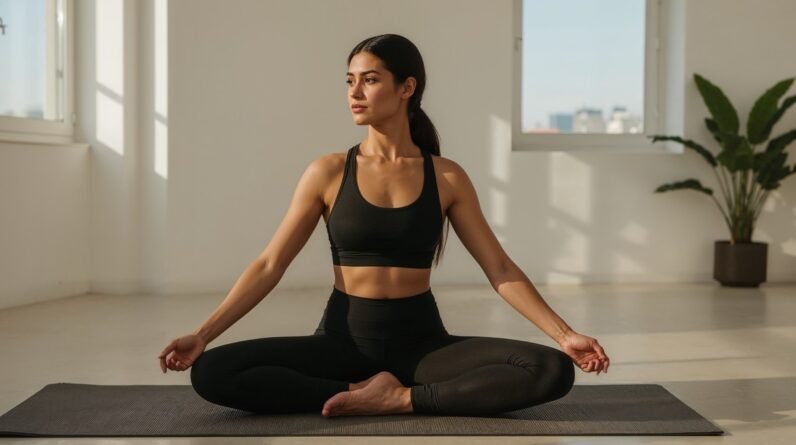
By making sure your spine is properly aligned, good posture minimizes the strain on your back and neck, significantly reducing the risk of chronic pain or injuries. It also allows your lungs to expand fully, improving oxygen flow to your muscles and brain. And proper posture contributes to better digestion and circulation, as it prevents the compression of your internal organs.
To give you all those benefits (and more), we’ve asked Alicia Rios, CSCS, personal trainer and programming manager for Bold, an at-home, digital fitness platform, to create a mobility routine to improve posture as part of our March 2024 Movement of the Month Club. She’s dedicated her career to creating personalized exercise prescriptions for people who want to maintain strength, mobility and independence as they age.
Below, Rios demonstrates each of the six simple (yet effective) mobility moves for posture, which you can then combine into a feel-good flow. They’re designed to strengthen your core, loosen up tight muscles, and align your spine, helping you master the art of perfect posture.
If you’re following along with this month, for week 3, you’ll do one move each day, Monday through Saturday. Then on Sunday, you’ll do the full 5-minute routine. Do each move for 50 seconds (25 seconds on each leg, where necessary) before moving on to the next one, for a total of 5 minutes.
If you’re feeling especially tight or if you have more time, feel free to do each move for as long as feels good.
1. Sunrise
This move, which you can do either sitting or standing, helps if you have rounded shoulders, opening them back up by activating the upper back and stretching the chest muscles.
- Sit in the middle of the seat of a chair with your knees bent to 90 degrees, knees over ankles.
- Bring your palms together at the center of your chest.
- Keep your chest tall and core engaged as you press your hands together and lift them over your head.
- Open your hands to the front as you circle your arms out to the sides.
- As you lower your arms, bend your elbows and bring them into your sides, forearms at a 45-degree angle to the floor.
- Pause, then reverse the movement all the way up to the top, where you’ll bring your palms together and then back to the center of your chest.
- Repeat.
2. Chicken Wings
Though this move has a funny name, it has serious benefits: It helps counteract the forward shoulder posture that comes from prolonged desk work, driving, or using electronics; it also strengthens the muscles that support good posture, reducing shoulder and neck tension.
Practice this several times throughout the day, especially if you spend long hours sitting or in front of a computer.
- Sit in the middle of the seat of a chair with your knees bent to 90 degrees, knees over ankles. Ensure your spine is aligned from your tailbone to the top of your head.
- Bend your elbows and bring your arms up and over your head so that your hands are touching your upper back, elbows pointing toward the ceiling.
- Slowly draw your shoulder blades back and down, as if you’re trying to pinch them together, while you open your elbows out to the sides. Keep your neck relaxed and your gaze forward.
- Gently draw your elbows back together.
- Repeat.
3. Thoracic Rotation
This mobility exercise is great for posture and can enhance your range of motion, making everyday movements easier and reducing the risk of injury.
- Sit in the middle of the seat of a chair with your knees bent to 90 degrees, knees over ankles.
- Lift your right hand and place it behind your head, with your elbow pointing out to the side. Place your left hand on your left knee.
- Rotate your upper body across and to the left, leading with your elbow.
- Open up to the right side and twist to look behind you, pointing the elbow back at a 45-degree angle (or as much as your flexibility allows). This movement should come from your thoracic spine (upper back), not your lower back.
- Hold the position for a moment to maximize the stretch. You should feel it in your thoracic spine and across your chest.
- Slowly bring your elbow back down and repeat.
- Now, place your left hand behind your head and repeat the rotation, this time opening up to the left side.
4. Thoracic Extension
Thoracic extensions are great for improving posture, reducing upper back pain, and enhancing your overall spinal mobility. You want to use a chair with a low back for this one.
- Sit in the middle of the seat of a chair with your knees bent to 90 degrees, knees over ankles.
- Cross both arms in front of your chest, hands on your upper arms.
- Gently allow your head, shoulders, and upper back to roll over the back of the chair, going only as far as is comfortable. Avoid arching your lower back; the movement should focus on your upper back. You should also feel a stretch in your thoracic spine and chest.
- Hold the extended position for a few seconds, then carefully bring yourself back to the starting position.
5. Figure 4 Forward Fold
This move opens up the hip joint, improves flexibility, and helps relieve pain in the lower body. It’s also a calming pose that can help reduce stress and tension.
- Sit in the middle of the seat of a chair with your knees bent to 90 degrees, knees over ankles.
- Place your right ankle on your left knee.
- As you exhale, hinge at the hips to fold forward over your leg. Lead with your chest rather than your head to avoid rounding your back.
- Hold the forward fold, breathing deeply. You should feel a gentle stretch in your lower back, hips, and possibly your hamstrings.
- Slowly lift up to sitting, uncross your legs, and give them a gentle shake if needed.
- Repeat with your left leg crossed over to your right knee.
6. Chin Retraction
Chin retractions are beneficial for those who spend a lot of time looking at screens or sitting at a desk, as it helps counteract the forward head posture that commonly develops from these activities. And you can do it multiple times throughout the day to relieve neck tension and improve posture.
- Sit up straight in a chair or stand with your back against a wall.
- Lightly place one finger on your chin. This is for guidance and to maintain awareness of the movement of your chin.
- Begin to gently retract your chin toward your neck, as if you’re trying to create a “double chin.”
- Hold the tucked position, feeling a gentle stretch in the back of your neck.
- Slowly relax and return your head to the starting position.
- Repeat.







